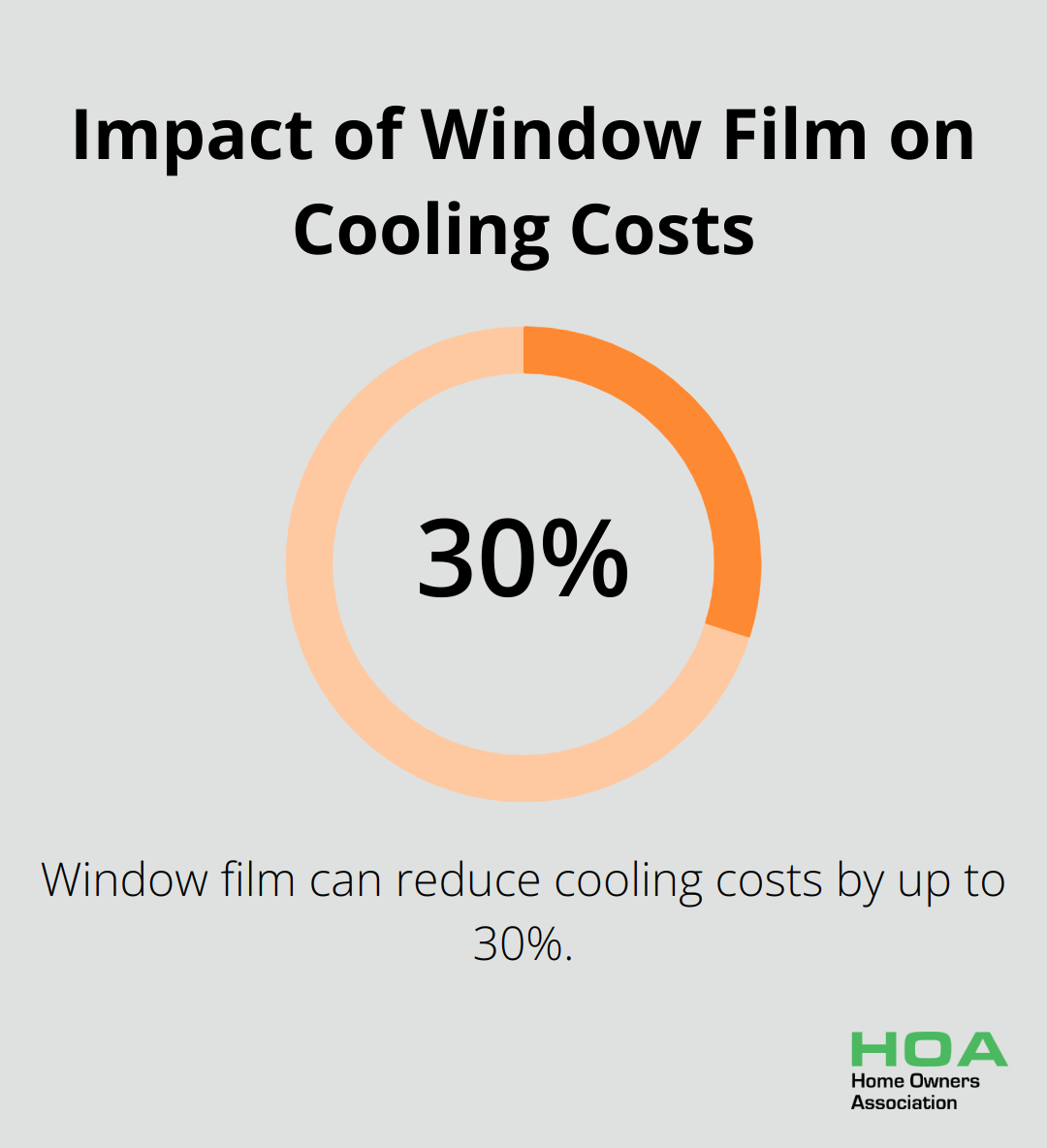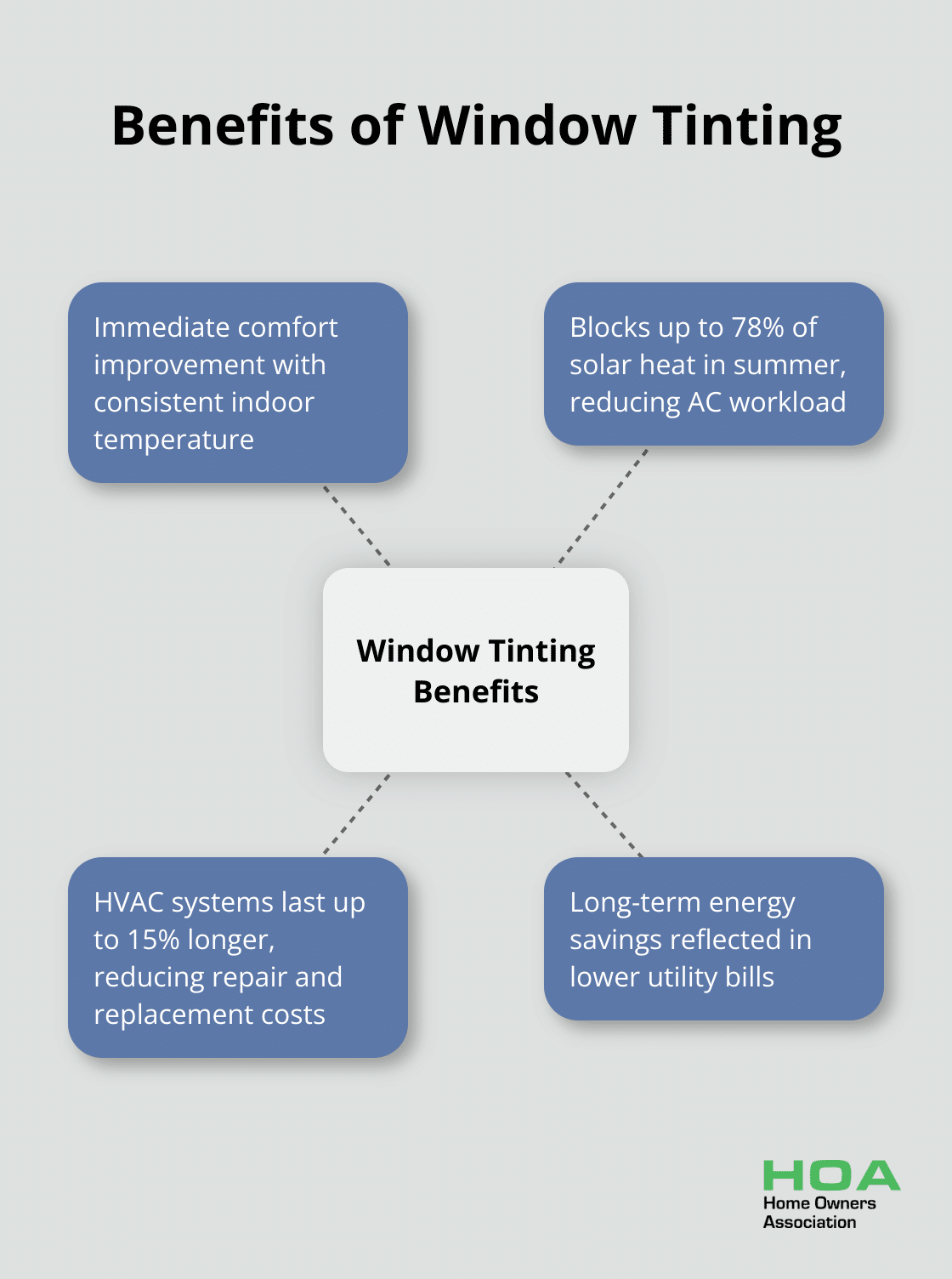
At Home Owners Association, we’re always looking for ways to help you save energy and reduce costs.
Does tinting home windows save energy? The answer is a resounding yes.
Window tinting is a simple yet effective solution that can significantly impact your home’s energy efficiency and comfort. In this post, we’ll explore how window tinting works, its benefits, and how to choose the right option for your home.
What Is Home Window Tinting?
The Basics of Window Tinting
Window tinting involves the application of a thin film to your home’s windows. This film acts as a barrier that controls the amount of light and heat entering your living space. The process transforms a home’s energy efficiency and comfort levels.
The Science Behind Window Tinting
Window tinting reflects and absorbs solar radiation, lowering the overall heat gain through windows. This process helps in reducing solar heat gain, which in turn improves energy efficiency in homes.
Types of Window Tinting Films
Several types of window tinting films exist, each with unique properties:
- Solar Control Films: These films block up to 99% of UV rays and reduce heat gain (ideal for hot climates where cooling costs are a concern).
- Low-E Films: These films provide insulation, retaining heat during winter and repelling it during summer (particularly effective in areas with extreme temperature fluctuations).
- Decorative Films: While primarily used for aesthetics, these films also offer some energy-saving benefits.
Energy Consumption Impact
Window tinting substantially impacts energy consumption. Window film can reduce cooling costs by as much as 30 per cent. In warmer climates, this translates to significant savings on energy bills.

Window tinting also reduces the load on your HVAC system, which extends its lifespan. This means fewer repairs and replacements, further contributing to long-term cost savings.
Installation Considerations
While DIY kits are available, professional installation often yields better results. Proper installation ensures maximum effectiveness and longevity of the window film.
The next section will explore the specific benefits of window tinting for energy savings, including reduced heat gain in summer and improved insulation in winter.
How Window Tinting Slashes Energy Costs
Year-Round Temperature Regulation
Window tinting transforms your home into an energy-efficient fortress. In summer, it blocks up to 78% of solar heat, which significantly reduces the workload on your air conditioning system. During winter, the film acts as an extra layer of insulation, trapping warm air inside. This dual action ensures your HVAC system operates efficiently in all seasons.
Dramatic Energy Bill Reduction
The impact of window tinting on energy bills is substantial. Window awnings can reduce solar heat gain in the summer by up to 65% on south-facing windows and 77% on west-facing windows. These aren’t minor adjustments; they represent significant reductions in energy expenses that accumulate rapidly over time.
Extended HVAC System Lifespan
Window tinting reduces the strain on heating and cooling systems, which extends their operational life. The International Window Film Association reports that HVAC systems in homes with window tinting last up to 15% longer than those in untreated homes. This longevity translates to fewer repairs and delayed replacements, resulting in additional long-term savings.
Professional Installation for Optimal Results
While DIY options exist, professional installation guarantees maximum benefits from your window tinting investment. Experts ensure proper application, which is critical for optimal energy savings. They also provide guidance on the best film types for your specific needs (climate, window orientation, and desired aesthetics).
Immediate and Long-Term Benefits
Window tinting offers both immediate and long-term advantages. You’ll notice an instant improvement in comfort as your home maintains a more consistent temperature. Over time, the cumulative energy savings will become increasingly apparent on your utility bills. This combination of immediate comfort and ongoing savings makes window tinting an attractive option for energy-conscious homeowners.

The next section will explore how to choose the right window tinting for your home, considering factors such as climate, window orientation, and personal preferences.
Selecting the Perfect Window Tint for Your Home
Climate Considerations
Your local climate determines the ideal window tint. Hot Australian climates (Queensland, Northern Territory) benefit from solar control films that block up to 80% of solar heat. Cooler regions (Tasmania) might prefer low-E films for insulation. In hot climates, window films can reduce the shading coefficient and solar heat gain by up to 44% and 22% if applied on the outside and inside, respectively.
Window Orientation
The direction of your windows impacts tint selection. North-facing windows in Australia receive direct sunlight year-round, making them ideal for high-performance solar control films. East and west-facing windows need films that reduce glare during sunrise and sunset. South-facing windows typically require less intense tinting but still need UV protection.
Aesthetic Preferences
Window tints offer various shades and finishes. For people who live in sun-soaked areas like Perth and the rest of Western Australia, solar window film is a great option. Lighter tints allow more natural light while providing energy benefits. Darker tints offer maximum heat rejection and privacy but may alter your view. Some homeowners prefer a neutral appearance that doesn’t change the look of their windows from the outside. Neutral-coloured films often provide the best balance of energy efficiency and aesthetics.
Energy-Efficient Film Options
Several high-performance options exist for energy-efficient window films:

Professional Installation vs DIY
Professional installation yields optimal results. Improper installation can reduce a film’s effectiveness by up to 50 per cent. Professional installers have the tools and expertise to ensure proper application, avoiding bubbles, creases, or gaps that compromise performance.
Professional installers provide valuable advice on the best film for your specific needs. They also ensure that the installation doesn’t void existing window warranties.
Final Thoughts
Window tinting transforms homes into energy-efficient havens. It reduces heat gain in summer, improves insulation in winter, and cuts energy bills significantly (up to 30 per cent in some cases). The long-term impact extends beyond immediate cost savings, as tinting prolongs HVAC system lifespan and reduces carbon footprints.
Quality products and proper installation are essential to maximise these benefits. Professional installation ensures optimal performance and longevity, with experts guiding homeowners to select the right film for their specific needs. This approach guarantees the best results for energy efficiency and comfort.
Home Owners Association helps Melbourne homeowners make informed decisions about energy-saving improvements. Our members access trade pricing and expert advice for their window tinting projects. Does tinting home windows save energy? The evidence clearly shows it does, making it a smart investment in comfort, savings, and environmental sustainability.





